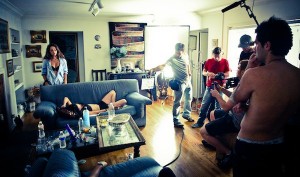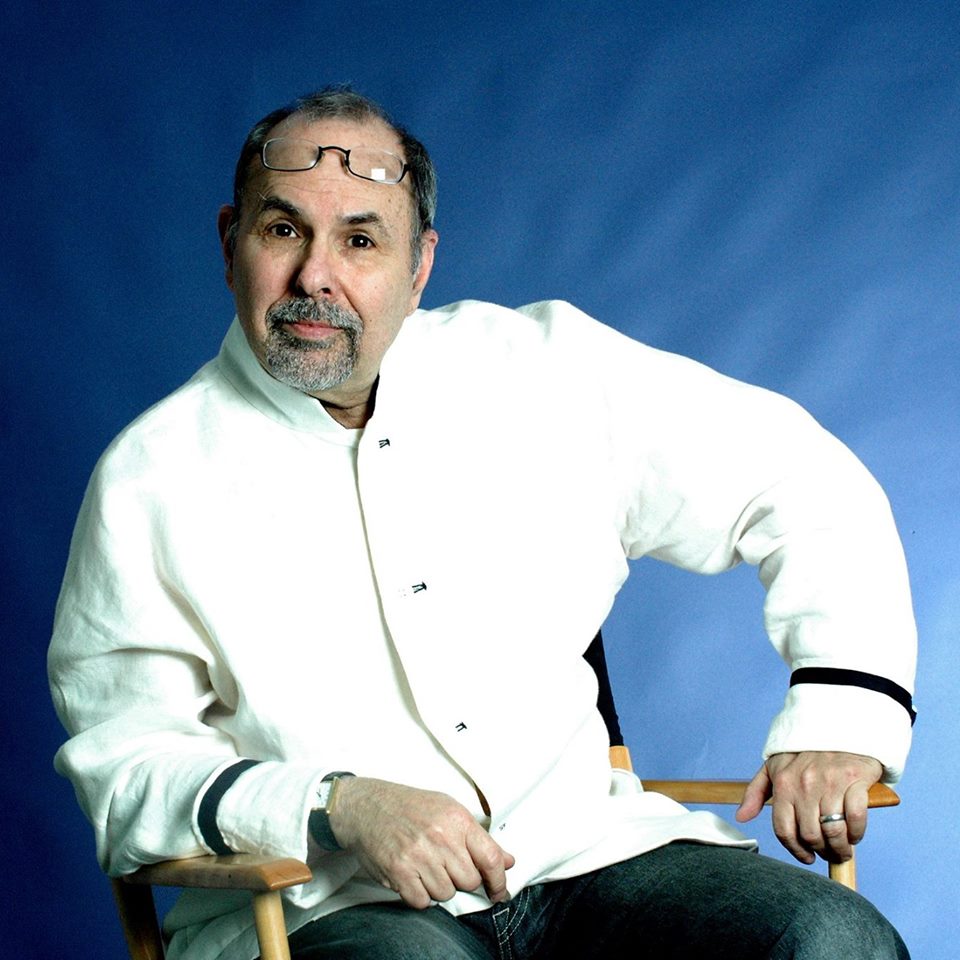THE MICRO BUDGET MOVIE MAKING ($100,000 Feature Film & 1 Hot Tip)
by Dov S-S Simens on December 20, 2018
MICRO-BUDGET FILM MAKING (Budget, Money, Script, Shoot, Crew & 1 Hot Tip)
(1) THE BUDGET: $50,000 to $100,000

(“With $50-100K and proper prep, you can produce and direct a quality 2-week shoot.”)
The previous post I outlined No-Budget Filmmaking (1-Week Shoot) when all you have is $5,000-$20,000.
Now, assuming you have $50,000 to $100,000, the topic is no longer “No-Budget Filmmaking” but “Micro-Budget Filmmaking”.
“No-Budget Filmmaking” ($5-20K) assumes you have a little cash handy (double up on Uber hours & get a 2nd shift at Starbucks), the 90-page script, 1-location (your apartment) and a DP friend with a 4K camera and a buddy who is a quality soundman with equipment… then go for it.
With “Micro-Budget Filmmaking”, and the need for $50,000 to $100,000, this means you must accomplish nominal film financing.
To learn Low-Budget Financing, there are hundreds of seminars given annually by Film Commissions, Film Associations, Film Co-Ops and Entrepreneurs calling themselves Summits, Expos, Symposiums & Webinars with titles like “Secrets & Tricks to Independent Financing” or “Movie Money: Ancillary Revenue Streams”, or “Pre-Selling Globally”, or “International Co-Productions”, “Government Financing Programs”… yadda-yadda-yadda.
And I beseech you to not become a seminar-junkie for bottomline, when looking for $50,000 to $100,000, assuming your parents are not wealthy, is there are only three methods (Pitching to studio execs ain’t one nor is Pre-Selling at Cannes or those Pitchathons) when you are not an established name.
3 MICRO-BUDGET FINANCING METHODS:
1st: PRIVATE PLACEMENT: This is an exotic way of stating you ask your friends and relatives (Aww Come-on. Gimmme some money. You can afford it) to invest.
Basically, this Private Placement Legalese states you got a Business License, Incorporated, Set up a Limited Liability Company, wrote an Offering Memorandum and sold “units” (a nice word for “shares” or “stocks”) when you are giving this opportunity to invest to usually less than 35 people.
You want $100,000. Then offer 50% of profits (if any… yuk-yuk) and sell 5 units (10%) at $20,000 each or 10 units (5%) at $10,000 each or 20 units (2.5%) at $5,000 each and raise the $100K. (if questions, my DVD or Streaming Film School programs spend 1-hour each detailing).
2nd: CROWD FUNDING (DONATION): This is Kickstarter and IndieGoGo. It is what I call “Legalized Begging”.
You post a photo or video of your project; you outline what it is all about and why it is great and post 6-8 levels of donations or gifts ($25, $50, $100….$5,000) in return for “thank yous”, “t-shirts”, “posters”, “DVDs”, “IMDB Credits”, etc.
In essence it is what PBS Network has been doing for 60 years.
Why I like it is it’s “Free Money” (aka: donations).
Actually it costs about 8% (Fees & Expenses) but if you raise your target amount you own the project 100%.
Cool.

(“Crowd Funding for donations works but Crowd Funding for equity is much better.”)
3rd: CROWD FUNDING (EQUITY): Post Obama’s JOBS Act of 2013/2015 individuals can now invest directly (aka: own equity) in startup companies marketed on the internet to accredited and non-accredited investors with amounts under $1,000 to as little as $10.
So create 20,000 shares of stock and offer 10,000 shares of stock (50% of the stock) at $10 each to raise the $100,000 and you still own 50% of the company.
Double-Cool.
These are sites like Fundable, WeFunder, EquityNet, CrowdFunder, Seed Invest, etc.
Do it.
However, to attract investors don’t just post your idea for a film and say “invest” you should slant the presentation to more of a business venture than a single film.
For instance, “Women-Make-Movies” (invest in a company that finances movies written-by-women, made-by-women, shot-by-women, edited-by-women, for-women) or “Christian Filmmakers” (invest in a production-distribution companies with spiritual uplifting storylines…that has guaranteed distribution via 10 streaming platforms, directly to the consumer).
Always remember; Investors want to invest in a business not a film.
(2) THE SCRIPT: 90-100 Pages, 2-3 Locations, No EXT-NIGHT
Your script is now be slightly more expansive (Hollywoodese “You Opened It Up”) than your No-Budget dressed up, 90-page, 1-location, stageplay-ish script.
You can now have 2, possibly 3 locations (ie. a house, a bar, a courtoom), for a change of scenery, with 75% of the pages taking place at one of the locations, but with the three locations never more than 4 city blocks (minimum movement) of each other and you have “opened-it-up”.
However, you still need 40-50 scenes, with a tremendous A-story and 3 superb Sub-Plots, told through characters with great dialogue, that comes to a satisfying crisis, resolution and conclusion.
(3) THE SHOOT

(“All Micro-Budget Features are 1-2 week shoots with 7-13 shooting days”)
Micro-Budget Features are normally 2-week shoots.
2-Week Shoots, working over 1-weekend, are 13-Day Shoots, with a 90-100 Page Script, that create a Shooting Schedule of 7-8 Pages/Day with two 4K cameras.
This is better than a 1-Week No-Budget Feature for it allows you more time to light, to rehearse and for the actors a little more time to do a 2nd take, if needed, for performance enhancement.
A further benefit of a 2-Week Micro-Budget Shoot over a 1-Week No-Budget Shoot is that work days are no longer 15-18 hours but a more manageable, but still tiring, 12-15 hours.
Working 15-18 hour days for two weeks will have the crew exhausted and hating you during the 2nd week.
Working 12-15 hour days for two weeks however, has the crew tired but believing, after they power-through the 2nd week, that they have accomplished something great.
(4) THE CREW: 5-6 Keys (7-8 Assistants)
With $100,000, and a 2-week shoot, you can offer Opening Title Credits to your 5-6 Keys and hire them for minimal salaries ($800-$1,500/week), for they actually want an Opening Title Credit on a Feature Film for their IMDB resume.
The 5-6 Keys are… Director, Cinematographer, Line Producer (aka: PM), Production Designer (aka: PD), Soundman, Grip/Gaffer & Editor…
Secondary titles will go to your Production Coordinator (aka: PC), Best Boy Grip, Shooter #2, Hair-Makeup and, of course, 4-5 Production Assistants ($200,000 USC Film School grads who each own a van or pickup… no van or pickup no PA gig).
(5) THE HOT TIP
No EXT-NIGHT. No EXT-NIGHT. No-EXT Night.
What do I mean by this?
Simple. With a Micro-Budget 2-Week Shoot you cannot handle any Exterior Night setups, scenes or shots.
So make absolutely sure there are none in the script.
Why?
Answer: Limitation of time for crew maintenance.
Huh?
Permit me to explain.
There are only 24 hours in a day with approx 12 hours of daylight. Thus, you desire to maximize the 12 hours of daylight shooting time.
Sun rises at 7:00am and sets at 7:00pm. Thus, to maximize time your Production Manager daily has his Production Coordinator, with a Cast & Crew List with everyone’s phone number, make a wakeup call at 5:30am and follows with a second wake-up call at 5:45am (no 2nd call and they go right back to sleep) to get the crew person out of bed, showered, in his/her car and to the set by 6:30am.
With Coffee ready at 6:25am (when crew arrives at set at 6:30am they go right to coffee) and the sun rising at 7:00am you should be able to get first shot by 7:15am.
Keep shooting until 1:00pm and break one-hour for lunch until 1:50pm.
2:00pm commence shooting until 8:00pm, a little after the sun goes down, to get your 7-10 pages in-the-can with 22-25 setups.
Phew.
Now, if you have EXT-NIGHT scenes you wait until 8:30pm when it is dark, shoot until daylight and then, now that the sun is up, start the next day’s EXT-DAY or INT-DAY or INT-NIGHT (Can shoot INT-NIGHT during day) shots.
I hope you get it. There is no Turn-Around Time.
This is not a Studio Guild & Union shoot with 36-hour Turn-Around times built into the schedule.
This is a Micro-Budget indy shoot with no Turn-Around Time.
Attempt just 3-5 pages of EXT-NIGHT in a Micro-Budget Indy shoot and you are going to have your crew awake and working, to include daylight shots, for 36-40 hours straight… and the day after will become totally disorganized, chaos will ensue and the shoot will fall apart… DON’T TRY IT! …No EXT-NIGHT.
Happy Film making… and for 100s of other practical film making tricks, never taught at traditional 4-year film programs, I implore you to take any of my three extremely practical, and affordable, film programs.
Enjoy your 2019 Film Career
Dov Simens
WHY WAIT?
LEARN… TO PRODUCE, WRITE, DIRECT & DISTRIBUTE…
Want to launch your film career?
Then either of my three proven film programs are perfect for you…
(Streaming! 3 Clicks. Start right now… www.WebFilmSchool.com)
(DVD! View over and over…www.WebFilmSchool.com)
(Live! Network! APR 6-7/2019, AUG 10-11/2019 or DEC 7-8/2019)
No-Theory. No-Bull.
Keep Up to date… Join our e-mail list.
http://webfilmschool.us10.list-manage.com/subscribe/post?u=313d0b336735c6d5fbf1a8e9d&id=2c55446523
*** NO-BULL ***









SEnd me only $6000 fr lunching my son in flim
Acountno..913010004275895
UTIB0001311
Axis bank
another tip. NO CHILD ACTORS. Child actors limit the amount of time you can work in a day (they can only work 8 hours max), they require a studio “teacher” to be on set (added costs), and they often take more time to get the shots. AVOID AT ALL COST.